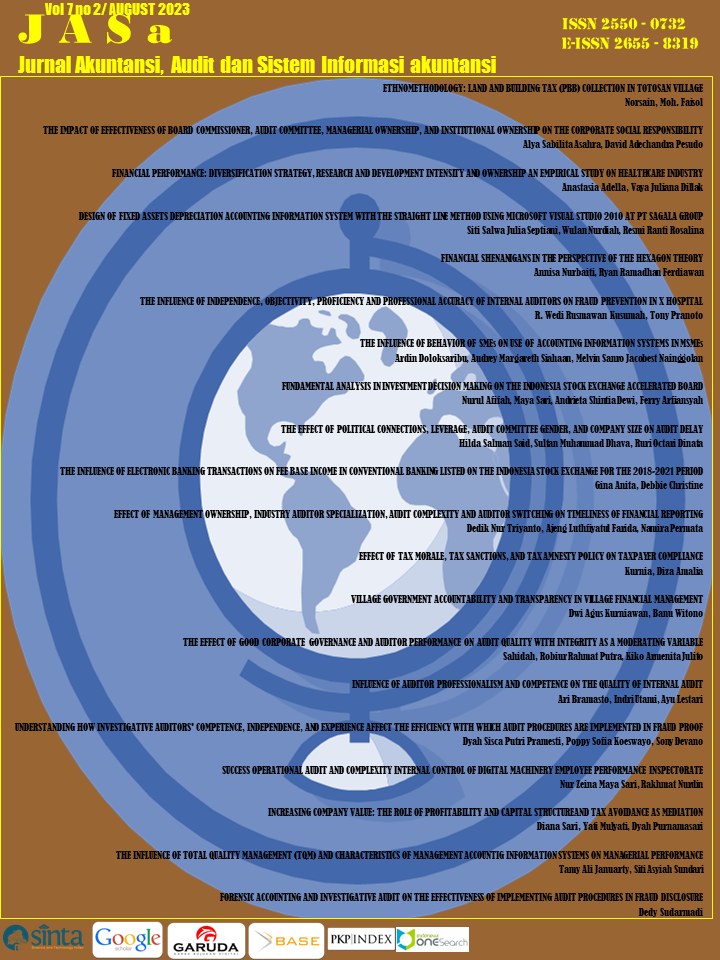Ethnomethodology: Land and Building Tax (PBB) Collection in Totosan Village
Main Article Content
Abstract
The aims of this reseach to find out how the Totosan village government collects PBB P2. Researchers collected research data using observation, interviews, and documentation, which conducted in-depth interviews with 5 informants. Data analysis through the stages of reduction, presentation, conclusion drawing and verification as well as ethnomethodological analysis with the help of NVivo R1 software. The method of PBB P2 collection carried out in Totosan Village is conditional on the value of local wisdom, where tax collection is carried out by (1) visiting the taxpayer directly; (2) provide education about PBB P2; and (3) provide solutions to problems related to P2 PBB collection and provide services in the P2 PBB payment process. In addition, village officials who have this task emphasized that they came to submit SPPT not to collect taxes, so that it seemed as if village officials were officers who collected taxes, even though they were only facilitators who submitted SPPT PBB P2. This study implies the theory that many ways of collecting taxes do not have to rely on existing legal rules because they create fear for taxpayers. Therefore, in ways that are local wisdom as a new alternative in tax collection.
Article Details

This work is licensed under a Creative Commons Attribution-NonCommercial-NoDerivatives 4.0 International License.
References
Almanshur, F., & Ghony, M. D. (2014). Metodologi Penelitian Kualitatif. Ar-Ruzz Media.
Awasthi, R., Nagarajan, M., & Deininger, K. W. (2021). Property taxation in India: Issues impacting revenue performance and suggestions for reform. Land Use Policy, 110, 104539.
Bandur, A. (2016). Metodologi Penelitian Kualitatif: Metodologi, Desain, dan Teknik Analisis Data dengan NVIVO 11 Plus. Mitra Wacana Media.
Basrowi dan Sudikin. (2002). Metode Penelitian Kualitatif Perspektif Mikro. Insan Cendikia.
Cagdas, V. (2013). An Application Domain Extension to CityGML for immovable property taxation: A Turkish case study. International Journal of Applied Earth Observation and Geoinformation, 21, 545–555.
Denzin, N. K., & Lincoln, Y. S. (2009). Handbook of Qualitative Research. Pustaka Pelajar.
Kamayanti, A. (2016). Metodologi Penelitian Kualitatif Akuntansi: Pengantar Religiositas Keilmuan. Yayasan Rumah Peneleh.
Mardiasmo. (2018). Perpajakan Edisi Terbaru 2018. Penerbit Andi. Yogyakarta.
Mardiasmo. (2021). Akuntansi Sektor Publik. Penerbit Andi.
Mariana, D. (2010). Otonomi Daerah dan Inovasi Kebijakan. Governance, 1(1), 13–20.
Miles, M., & Huberman, M. (1994). Qualitative data analysis: An expanded sourcebook. Sage Publications. https://www.google.com/books?hl=en&lr=&id=U4lU_-wJ5QEC&oi=fnd&pg=PR12&dq=Qualitative+data+analysis+Miller+Matthew&ots=kEWF2GTWXP&sig=5nuE4nXb5F3bXqVsFEHIpybw01U
Mirdah, A. (2016). Intensifikasi Pemungutan Pajak Bumi dan Bangunan di Dinas Pendapatan Daerah Kabupaten Sarolangun. Jurnal Manajemen Terapan Dan Keuangan, 5(3), 164–175.
Moleong, J. L. (2014). Metodologi Penelitian Kualitatif. PT Remaja Rosdakarya.
Morgan, G. B. G. (1979). Paradigms, Sociological Analysis, Organizational. Sociology The Journal Of The British Sociological Association, 3(4), 380–381. http://search.ebscohost.com/login.aspx?direct=true&db=bth&AN=5963638&site=ehost-live.
Pietersz, J. J., Picauly, B. C., Widaryanti, W., Katili, A. Y., Ririhena, M. Y., Ferayani, M. D., Dewi, M. S., Faisol, M., Kurniati, N., Sandra, A., Wicaksono, G., Said, H. S., Zulma, G. W. M., Suripto, S., & Koerniawati, D. (2021). Perpajakan (Teori & Praktik). In Widina Bhakti Persada Bandung. Widina Bhakti Persada Bandung.
Poloma, M. M. (1979). Contemporary Sociological Theory. Collier Macmillan.
Ratuela, G. J. (2015). Evaluasi pelaksanaan pemungutan dan prosedur pencatatan Pajak Bumi dan Bangunan Perdesaan dan Perkotaan (PBB-P2) sebagai pajak daerah di Kota Bitung. Jurnal Berkala Ilmiah Efisiensi, 15(5).
Resmi, S. (2019). Perpajakan: Teori & Kasus (10th ed.). Salemba Empat.
Soewardi, T. J., & Ananda, C. F. (2015). The Transformation of Bea Acquisition Rights to Land and Buildings (BPHTB): Case Study in Kediri City of East Java. Procedia-Social and Behavioral Sciences, 211, 1179–1185.
Sofi, I. (2021). Mendorong Kemandirian Daerah Melalui Optimalisasi Pendapatan Asli Daerah. DJPK, 1. https://www.kemenkeu.go.id/publikasi/artikel-dan-opini/mendorong-kemandirian-daerah-melalui-optimalisasi-pendapatan-asli-daerah/
Sugiyono. (2014). Memahami Penelitian Kualitatif. Alfabeta.
Tobari. (2021, November 6). BPPKAD Sumenep Tumbuhkan Kesadaran Masyarakat Bayar PBB. Info Publik, 1. https://infopublik.id/kategori/nusantara/578912/bppkad-sumenep-tumbuhkan-kesadaran-masyarakat-bayar-pbb#:~:text=Dielaskan Suhermanto jika PBB Kabupaten,PAD) sebesar Rp5 miliar pertahun.
Triyuwono, I. (2012). Akuntansi Syariah Perspektif, Metodologi, dan Teori. PT Raja Grafindo Persada.
Waluyo. (2017). Perpajakan Indonesia (11th ed.). Salemba Empat.
Williantara, G. F., & Budiasih, I. G. A. N. (2016). Pengaruh pendapatan asli daerah, dana alokasi umum, dana alokasi khusus, dan dana bagi hasil pada indeks pembangunan manusia. E-Jurnal Akuntansi, 16(3), 2044–2070.
Yin, R. K. (2015). Studi Kasus Desain & Metode. Raja Grafindo Persada.
Yuliana, E. S., Tarmizi, T., & Soraya, S. (2019). Efektivitas Implementasi Pemungutan PBB P2 Kota Pontianak. Eksos, 15(2), 129–136.

